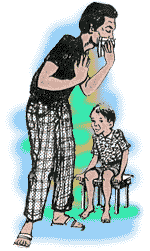Airway Management of Tuberculosis
Pulmonary tuberculosis (TB) is caused by the bacteria Mycobacterium tuberculosis (M. tuberculosis). M. tuberculosis is an aerobic, nonmotile, non-spore-forming rod that is highly resistant to drying, acid, and alcohol.
The probability of transmission from one person to another depends on the number of infectious droplets expelled by a carrier, the duration of exposure, and the virulence of the M. tuberculosis.
Most people who develop symptoms of a TB infection first became infected in the past. However, in some cases, the disease may become active within weeks after the primary infection.
The following people are at higher risk for active TB:
- Elderly
- Infants
- People with weakened immune systems, for example due to AIDS, chemotherapy, diabetes, or certain medications.
- Increase in HIV infections
- Increase in number of homeless people (poor environment and nutrition)
- The appearance of drug-resistant strains of TB
A definitive diagnosis of TB can only be made by culturing M. tuberculosis organisms from a specimen taken from the patient. However, TB can be a difficult disease to diagnose, mainly because of the difficulty in culturing this slow-growing organism in the laboratory. A complete evaluation for TB must include a medical history, a chest radiograph, a physical examination, and microbiologic smears and cultures. It may also include a tuberculin skin test and a serologic test.
Airway Management of Tuberculosis
The most common cause of inflammatory stricture of the bronchus is TB. Tracheobronchial TB has been reported in 10–20% of all patients with pulmonary TB. The principal CT findings of airway TB are circumferential wall thickening and luminal narrowing, with involvement of a long segment of the bronchi. In active disease, the airways are irregularly narrowed in their lumina and have thick walls, whereas in fibrotic disease, the airways are smoothly narrowed and have thin wall. The left main bronchus is involved more frequently in fibrotic disease, whereas both main bronchi are equally involved in active disease.
Nursing Care Plan for Tuberculosis
Nursing Diagnosis : Ineffective Airway Clearance related to increased efforts to decrease sputum and cough.
Goal :: Improve cleanliness is to decrease airway secretions and repair ien to cough.
Intervention:
1. Encourage clients to drink 8 glasses of water / 2 liters of water a day (other than milk) for dilution secretion, while milk may increase the secretion.
R / Reassure clients that water moisturizes breathing.
2. Reassure clients that water moisturizes breathing.
R / Humidity helps airway secretions and allowing greater.
3. Encourage clients to cough effectively and breathe deeply.
R / proper coughing technique, a way to remove the sputum.
4. Encourage clients to rest between intervals cough and to change positions every 12 hours when possible.
R / Rest and changing position helps to reduce fatigue and overall spending sputum, insert oxygen to regenerate the cells.
5. Explain to the client's intended use of expectorant if found.
R / Expectorants help to loosen airway secretions and expenses.
6. Observations sputum characteristics coming out, discoloration, odor consistency / amount. Report immediately if there is a change.
R / normal sputum is thin and translucent white when mixed with blood, may indicate purulent complications.
ads

0 komentar:
Post a Comment